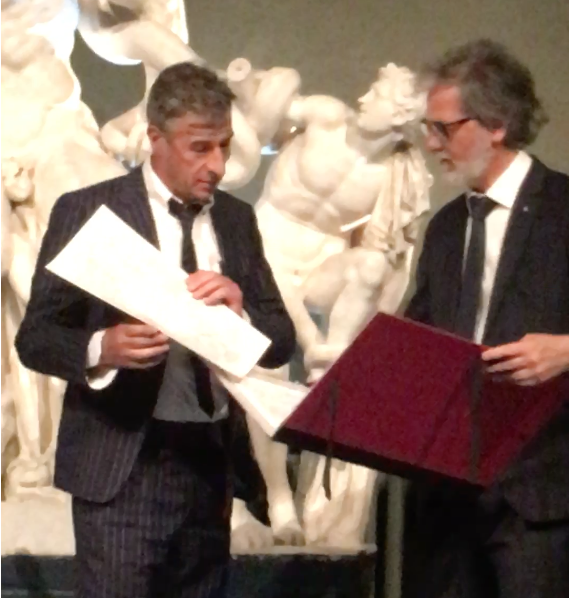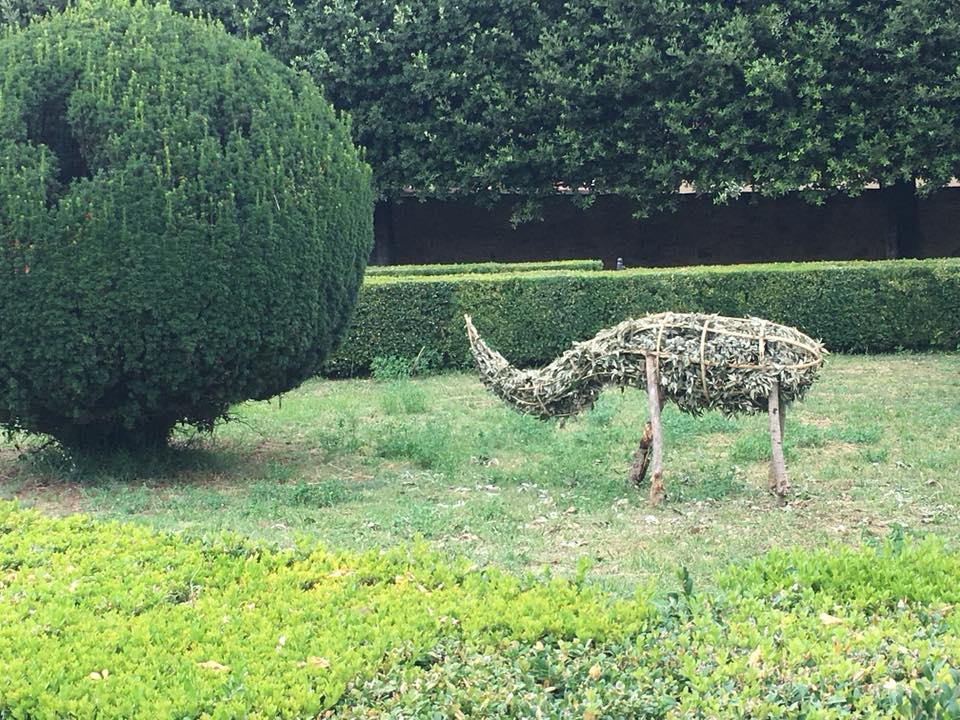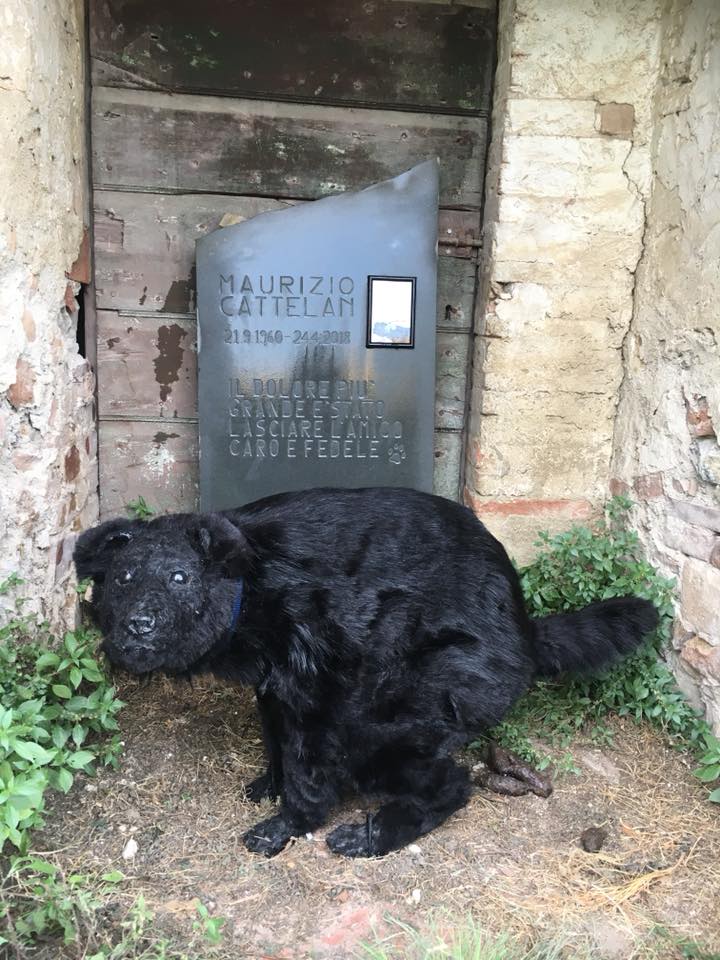ARTRIBUNE: Maurizio Cattelan (e 200 artisti giovanissimi) nella rassegna Forme del Verde a Siena – By Santa Nastro – 8 agosto 2018
Maurizio Cattelan si presenta a San Quirico d’Orcia con l’installazione-cimitero Eternity. Il tutto avviene fino al 28 settembre nell’ambito della rassegna Forme del Verde che invita inoltre gli studenti delle Accademie di Carrara e Firenze. A cura di Gaia Pasi.
In uno scambio di battute estivo sul tema delle biennali – biennali si, biennali no – avvenuto in queste settimane a colpi di pamphlet sulle pagine de La Stampa/ Tuttolibri e Dagospia tra Francesco Bonami e Luca Beatrice, quest’ultimo definisce così Maurizio Cattelan (Padova, 1960): “ha smesso di produrre arte, impiega tutto il suo tempo nelle relazioni sociali e si veste come il nonno di un cubista scemo”. Nel frattempo l’artista – che di Bonami e Beatrice è più o meno coetaneo-, ha inaugurato in provincia di Siena, a San Quirico D’Orcia, un nuovo intervento, che gli calza addosso gli abiti del padre più di quelli del vecchio signore. Insieme a Cattelan, infatti, hanno lavorato i giovani artisti dell’Accademia di Belle Arti di Carrara, su invito (e con borsa di studio) del “maestro” stesso. La joint venture con l’Accademia è di recente, ma significativa data: l’artista infatti è stato nominato Professore onorario lo scorso aprile, in una cerimonia nella quale non sono mancati i colpi di scena.

CONSEGNARSI IN ANTICIPO ALL’ETERNITÀ
Tra questi, la presentazione di Eternity, la grande installazione-performance sul tema della morte, che oggi arriva in provincia di Siena trasformando il giardino pubblico degli HortiLeonini, che hanno mantenuto la struttura originale del XVI secolo, in un cimitero. Un’ampia collezione di lapidi che recano i nomi di artisti del passato o del presente è stata realizzata in marmo o altre tecniche dagli allievi dell’Accademia, coordinati dai docenti. In questo grande cimitero, con le lapidi di artisti morti e viventi figurano anche la stele dello stesso Cattelan, che riporta come data di morte il 24 aprile 2018 e l’epigrafe Alienava te Minor Stremi e quella del direttore dell’Accademia – qui il resoconto di Artribune – . L’installazione, realizzata ed esposta per la prima volta a Carrara, oggi trasloca agli Horti Leonini di San Quirico D’Orcia, nell’ambito di Forme nel Verde, la rassegna curata da Gaia Pasi con il titolo, per il 2018, Pause, tra caos e armonia. Il tema della morte, ma anche e soprattutto di come ci si consegna all’eternità, è il messaggio che questa opera vuole trasmettere, trasformando il giardino in un cimitero, ritratto in una visione di insieme, nell’attimo di requie. E un pantheon ben definito di “compagni” tra i quali sentirsi pari – Manzoni, Caravaggio, Beuys, Magritte, Burri -. Parrebbe quasi che il “nonno del cubista scemo” stia ribadendo con quest’opera la sua appartenenza di diritto alla storia dell’arte.

FORME NEL VERDE
L’intervento è stato presentato in provincia di Siena nell’ambito della rassegna Forme nel Verde, giunta alla 48. edizione. “Esiste dal 1971”, spiega la curatrice Gaia Pasi, “dopo la Biennale è la rassegna più longeva di Italia con la differenza che è annuale. Sostenuta dal Comune, ha vissuto fasi alterne, fino alla necessità di un rilancio. Ho pensato che fosse importante costruirlo ripartendo dai giovani, la materia di cui mi occupo da sempre. Credo sia importante sostenere le loro idee, confrontarsi con loro, anche perché saranno l’arte del futuro. Quindi Luciano Massari il direttore dell’Accademia di Carrara mi ha invitata alla cerimonia per Cattelan, dove ho visto Eternity e mi è sembrato interessante riproporlo per due motivi: il primo è che mi ha dato la possibilità di lavorare con i moltissimi studenti che avevano realizzato la lapide per la borsa di studio messa in premio da Maurizio, il secondo è che lavorare con questa opera e con la regia di un artista di calibro internazionale innalzava immediatamente il livello di qualità della rassegna Forme Nel Verde dandole un taglio del tutto diverso”.

COME SI SVOLGE
La rassegna presenta quest’anno le opere di oltre 200 under 35 provenienti dalle Accademie toscane (Carrara e Firenze). Il percorso si conclude a Palazzo Chigi con i lavori realizzati dagli studenti della scuola di pittura di Firenze, mentre l’intero borgo con i suoi 2600 abitanti è disseminato di opere sonore, installazioni site specific, interventi di street poster art, performance. “Il progetto di quest’anno prende spunto da una frase di Nietzsche che medita sull’impossibilità dell’uomo di raggiungere un equilibrio stabile tra caos e armonia; la morte è l’armonia suprema del corpo (intesa come assenza di movimento) quando l’alito che lo fa vibrare raggiunge un altro posto… gli eterni sono pochissimi, ma è interessante riflettere sul fatto che l’eternità ce la conquistiamo in vita… il cimitero di Cattelan zoomma su questo, ci sono anche i vivi già presumibilmente eterni tra i morti di Cattelan, Cattelan in primis”.
-Santa Nastro

Maurizio Cattelan presents himself at San Quirico d’Orcia with the cemetery installation Eternity. Everything takes place until 28 September as part of the Forme del Verde exhibition, which also invites students of the Florentine and Carrara Academies of Fine Art. Curated by Gaia Pasi.

In a summer exchange of jokes on the theme of biennales – biennales yes, biennales no – which took place in recent weeks with the help of pamphlets on the pages of La Stampa/ Tuttolibri and Dagospia between Francesco Bonami and Luca Beatrice, the latter defines Maurizio Cattelan (Padua, 1960) as follows: “he has stopped producing art, he spends all his time in social relations and he dresses up as the grandfather of a stupid cubist”. In the meantime, the artist – who is more or less the same age as Bonami and Beatrice – has inaugurated a new project in the province of Siena, in San Quirico D’Orcia, which fits his father’s clothes more than those of the old lord. Together with Cattelan, in fact, the young artists of the Academy of Fine Arts of Carrara have worked on an invitation (and with a scholarship) of the “master” himself. The joint venture with the Academy is a recent, but significant date: the artist was in fact appointed Honorary Professor last April, in a tumultuous ceremony.

TO SURRENDER ONESELF IN ADVANCE TO ETERNITY
The presentation of Eternity, the great performance-installation on the theme of death, which today arrives in the province of Siena to transform the Horti Leonini public garden, which has kept its original sixteenth century structure, into a cemetery. A large collection of tombstones bearing the names of artists of the past and present was made of marble or other techniques by the students of the Academy, coordinated by the teachers. In this large cemetery, with gravestones of dead and living artists, is the tomb of Cattelan himself, which shows April 24,

FORME NEL VERDE
The intervention was presented in the province of Siena as part of the Forme nel Verde exhibition, now in its 48th edition. “It has existed since 1971”, explains the curator Gaia Pasi, “after the Biennale it is the longest running exhibition in Italy, its only difference with the Biennale is that it is annual. Supported by the Municipality, it has lived through alternating phases, up to the need of a relaunch. I thought it was important to build it starting from young people, the subject that I have always been involved in. I think it is important to support their ideas, to confront them, also because they will be the future of art. So Luciano Massari, the director of the Academy of Carrara, invited me to the ceremony for Cattelan, where I saw Eternity and I thought it was interesting to propose it again for two reasons: first is that it gave me the opportunity to work with the many students who had made the tombs for the scholarship awarded by Maurizio, the second is that working with this work and with the direction of an artist of international caliber immediately raised the quality level of the Forme Nel Verde exhibition giving it a completely different cut.

HOW IT DEVELOPED
This year the exhibition presents the works of more than 200 under 35 from the Tuscan Academies (Carrara and Florence). The exhibition ends at Palazzo Chigi with works created by the students of the Florence school of painting, while the entire village with its 2600 inhabitants is done with sound works, site specific installations, interventions of street poster art, and performances. “This year’s project takes its cue from a phrase by Nietzsche that meditates on the impossibility of man to achieve a stable balance between chaos and harmony; death is the supreme harmony of the body (understood as the absence of movement) when the breath that makes it vibrate reaches another place… the eternals are very few, but it is interesting to reflect on the fact that we conquer eternity in life… the cemetery of Cattelan zooms in on this, there are also the already presumably eternal living among the dead of Cattelan, Cattelan in primis”.
-Santa Nastro
– click here for the article on Artribune –

